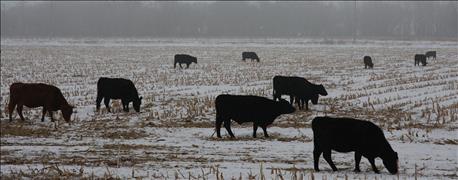August 21, 2015

With finicky weather this summer, the status of hay stockpiles may vary across states. Some may be large, others skimpy – while quality is up in the air.
According to Iowa State University Extension cow-calf specialist Patrick Gunn, some producers may only have one more cutting of hay available, and should prepare a winter feed budget now to plan for feed price increases after Jan. 1.
Here are 7 considerations when balancing winter feed needs and costs without sacrificing animal performance this winter, according to Gunn:

7 considerations for preparing this winter's cattle feed rations (Thinkstock/Darcy Maulsby)
1. Get weights on cows as well as forage. Most producers tend to underestimate the weight of their cows, and overestimate the weight of their bales. Having a correct cow weight will allow you to develop the most appropriate ration/supplementation scheme.
2. Calculate loss. Remember that what is baled is not what the cows either have the opportunity to consume or will consume. Consider the current storage method and estimate the amount of storage loss as well as potential feeding losses that may occur.
3. Consider using cornstalks, either grazed or baled, to extend forage supplies. However, use caution when relying on stalks for winter forage. Hope for the best but expect the worst as a wet fall can result in poor quality stalks, poor grazing conditions and a baled product that has more value as bedding than feed.
4. Plan ahead. Hay prices are as low as we have seen in a few years. If projected forage resources are short, consider buying hay now while prices are still low.
5. Test forages (all cuttings, all types). "In my opinion, this is the best money spent on any feeding program and likely the best return on investment for the entire enterprise," Gunn says. If you are overfeeding, you are wasting money. If you are underfeeding, you are losing money through loss of production.
6. Consider supplements. Work with a multitude of outlets to identify economical protein or energy supplements available in the area. Then, work with your nutritionist or extension specialist to develop least-cost diets that meet the needs of your cows for all winter production stages. Make sure you only supplement protein when necessary; likewise with energy. Don't buy or feed what you don't need.
7. Don't underestimate. Add 30 days to your typical winter feeding timeline. Cool, wet springs have delayed pasture turnout the past two years. Turning cows out too early next spring because harvested feeds are gone is a potential recipe for pasture disaster.
Growing Beef Newsletter, Iowa Beef Center
You May Also Like




